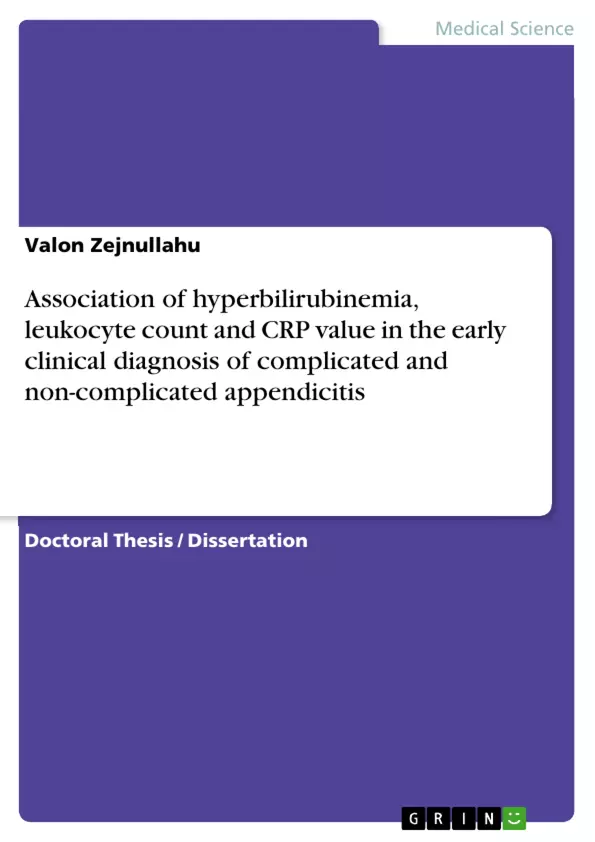This study aims to establish the role of hyperbilirubinemia as a laboratory marker in prediction of acute appendicitis in the early diagnosis and complicated appendicitis, as well as to compare laboratory markers such is C - reactive protein, Aspartate Aminotransferase (AST), Alanine Aminotransferase (ALT) and WBC together with Alvarado scoring model. Even though appendicitis has been known since two centuries ago, acute appendicitis presents a diagnostic challenge for the majority of general surgeons during their work, regardless of several diagnostic modalities applied.
This is a cross-sectional study, conducted in the University Clinical Center of Prishtina in the Department of Abdominal Surgery and in General Hospital of Mitrovica. The prospective data collection included 201 patients admitted in the emergency ward with suspicion for acute appendicitis, in which the preoperative diagnosis of acute appendicitis was established and appendectomy was performed, during the period from September 2016 up to October 2017.
Inhaltsverzeichnis (Table of Contents)
- LIST OF ACRONYMS AND ABBREVIATIONS...
- LIST OF FIGURES.
- LIST OF TABLES..
- ABSTRACT.
- 1. INTRODUCTION
- 2. LITERATURE REVIEW.
- 2.1. Historical Background.....
- 2.2. Embryology, anatomy and histology of the appendix.
- 2.3. Epidemiology of Appendicitis.
- 2.4. Ethiopatogenesis and Classification of Appendicitis.…….......
- 2.4.1. Non-complicated acute appendicitis
- 2.4.2. Complicated acute appendicitis..
- 2.5. Diagnosis of Acute Appendicitis
- 2.5.1. Clinical manifestation and physical evaluation..
- 2.6. Scoring Systems.
- 2.7. Laboratory Markers in Evaluation of Acute Appendicitis.
- 2.7.1. Leucocytes....
- 2.7.2. C-reactive protein (CRP)....
- 2.7.3. Production, metabolism, storage and excretion of the bilirubin.….........
- 2.7.4. Clinical relevance of hyperbilirubinemia in acute appendicitis ..........
- 2.7.5. Liver Enzymes.......
- 2.8. Imaging Methods in Diagnosis of Acute Appendicitis-Characteristic Features.....
- 2.9. Ultrasound Examination....
- 2.10. Computed Tomography (CT)
- 2.11. Magnetic Resonance (MRI) in Diagnostic Approach of Acute Appendicitis...........
- 2.12. Surgical Exploration .......
- 2.13. Differential Diagnosis
- 2.13.1. Meckel's diverticulitis
- 2.13.2. Acute ileitis
- 2.13.3. Cecal diverticulitis..
- 2.13.4. Crohn's disease
- 2.13.5. Urologic Disorders.
- 2.13.6. Gynecologic Disorders...
- 2.13.7. Tubo-ovarian abscess.....
- 2.14. Treatment.
- 2.15. Outcomes, Risks and Complications after Appendectomy
- 3. AIM OF THE STUDY
- 4. MATERIALS AND METHODS
- 4.2. Study Design...........
- 4.3. Study sample...
- 4.4. Inclusion criteria.
- 4.5. Exclusion criteria..
- 4.6. Data Collection
- 4.7. Statistical Analysis........
- 5. RESULTS.
- 5.1. Gender Distribution.
- 5.2. Age Distribution
- 5.3. WBC in complicated and non-complicated appendicitis
- 5.4. Bilirubin level between two groups of studies
- 5.5. Comparison of CRP level in complicated and non-complicated appendicitis.........
- 5.6. Level of liver transaminase in complicated vs non-complicated appendicitis .......
- 5.7. Alvarado scoring model between complicated vs non-complicated appendicitis..
- 5.8. Histopathology......
- 6. DISSCUSION.
- 7. CONCLUSION
- 8. REFERENCES..
Zielsetzung und Themenschwerpunkte (Objectives and Key Themes)
This dissertation focuses on the association of hyperbilirubinemia, leukocyte count, and CRP value in the early clinical diagnosis of complicated and non-complicated appendicitis. The aim is to investigate the potential of these biomarkers in differentiating between these two conditions, contributing to a more accurate and timely diagnosis.
- The epidemiology and classification of appendicitis.
- The role of laboratory markers, including hyperbilirubinemia, leukocyte count, and CRP, in the diagnosis of appendicitis.
- The application of scoring systems, imaging techniques, and surgical exploration in diagnosing and managing appendicitis.
- The differential diagnosis of appendicitis.
- The outcomes, risks, and complications following appendectomy.
Zusammenfassung der Kapitel (Chapter Summaries)
- Chapter 2: Literature Review: This chapter provides a comprehensive overview of the existing knowledge on appendicitis, covering its historical background, embryology, anatomy, epidemiology, and pathogenesis. The chapter delves into the different types of appendicitis, including complicated and non-complicated forms. It discusses various diagnostic methods, including clinical evaluation, laboratory markers, imaging techniques, and surgical exploration. The chapter also examines the differential diagnosis of appendicitis, exploring conditions that share similar symptoms.
- Chapter 3: Aim of the Study: This chapter clearly states the objective of the research, which is to investigate the association of hyperbilirubinemia, leukocyte count, and CRP value in the early clinical diagnosis of complicated and non-complicated appendicitis.
- Chapter 4: Materials and Methods: This chapter outlines the study design, participant selection criteria, data collection methods, and statistical analysis procedures used in the research. It details the inclusion and exclusion criteria for the study participants and the specific data points collected and analyzed.
- Chapter 5: Results: This chapter presents the findings of the research, including detailed analysis of the collected data. It examines the distribution of participants by gender and age, and investigates the levels of hyperbilirubinemia, leukocyte count, and CRP in relation to complicated and non-complicated appendicitis. The chapter also explores the application of the Alvarado scoring model in differentiating between these two forms of appendicitis and examines the correlation between liver enzyme levels and appendicitis.
Schlüsselwörter (Keywords)
The research focuses on appendicitis, its diagnosis and differentiation, with a focus on laboratory markers such as hyperbilirubinemia, leukocyte count, and CRP value. The study investigates the clinical relevance of these markers in the early diagnosis of complicated and non-complicated appendicitis, aiming to improve diagnostic accuracy and patient outcomes.
- Quote paper
- Dr. Valon Zejnullahu (Author), 2018, Association of hyperbilirubinemia, leukocyte count and CRP value in the early clinical diagnosis of complicated and non-complicated appendicitis, Munich, GRIN Verlag, https://www.grin.com/document/1268301



